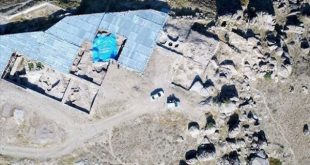 The first people will go to Mars in 2020.
The first people will go to Mars in 2020.
Now, Nasa is hard at work on the construction of the rocket and the capsule.
Gradually open access and the media. For example, the user space, the company allowed Wired to the photographer Vincent Fournier to spend twenty days with the designers and engineers of the project.
Engineers are trying to check all possible detail. For example, how vibration can affect other components in the system, or whether the fuel containers to withstand the critical situation under the pressure of another body weighing hundreds of tons.
“You know the saying, try twice, cut once? We brought the test to a new level,” notes Andy ADJ, Director of NASA loads.
The main part of the rocket is created by high-tech welding. Metal spinning tility between the plates of aluminium, melting them until creamy. Then metal sections are glued together into a single material which is being tested for defects using x-rays and ultrasound. The designers note that this is in some ways a technological breakthrough, after all, managed to melt the solid materials, having used the processes of zamorachivat.
A 130-foot hydrogen fuel tank so bulky that change its position from vertical to horizontal and Vice versa takes three days. Working on this two cranes with GPS technology and a special laser alignment system. Human involvement in the process of further work on the tank is almost not needed. Although one worker is still there. He looks, everything was in order, and, if necessary, stops all operations.
Two technicians in NASA for three months will be engaged in the adapter, which connects the main section of the missile with the capsule. They will be manually injecting an insulating material that achieves the perfect level layer. To achieve perfection, experts practiced hundreds of hours and spent about 50 tests.
Adapter when heated, can withstand more than 93 degrees.
The engine, of course, is extremely stable. Withstands temperatures from 217 ° to 3315 degrees Celsius in different sites and 907 thousand pounds of thrust on the rise.
Two steps attached to the inner Baku – the strongest part of the main compartment. The LHC itself consists of 7.5 thousand bolts and eight panels, it shone x-rays, and conducted a test using 100 hydraulic actuators, some of which are heavier than passenger cars.
Eight kilometers of wires 46 connect the electronic devices that control everything from navigation to engines. In most NASA cable web called the “nervous system” of the rocket.
Each device is tested with changes in temperature (from extreme cold to heat) and vibration. Then they attach to a model rocket to the devices tested full cycle, as in real life.
The outer surface of electronic devices equipped with computers that simulate the environment inside the rocket in different periods – from take-off to staging. The sensor serves indicators on the temperature – from low to high, passed the coordinates to the onboard computer, as well as other flight data. Check that the signal is securely held on the cables are all eight miles.
To ensure that the missile can withstand supersonic wind on takeoff and during the flight, NASA engineers test every part in a special wind tunnel, with a length of 100 meters. A tube that changes color from pale to bright pink depending on the amount of oxygen, and hence the pressure level. So engineers can accurately determine the force with which the wind would affect the rocket, particularly the separation steps. This process occurs within a few minutes, and space for mistakes there. For example, researchers are trying to do everything possible to stage in the separation came back and hit the vehicle body.
Capsule created with 3D printing technology, and it holds, recall, six passengers. Three years ago, the capsule has passed a series of tests, even went into space and fell into the Pacific ocean.
By the way, this moment is also practiced. In particular, the sailors are trained to catch and rescue the astronauts, which should be in the ocean. Working on force majeure. For example, the team simulates the situation when the load in the pad struck by lightning. Or, for example, think of the protection of the crew from solar flares.
During the experiments the engine virtually runs the startup process. The only difference from the real situation that the missile is not attached. Engineers watching from a safe distance.
See also: Italian surgeon shared the secret of immortality
We will remind that the rocket will go into space in 2019, fly far beyond Earth’s orbit. In the 2020 plan to launch a rocket with the capsule, i.e., with the crew. But the final goal of the mission is Mars.
© 2017 – 2019, paradox. All rights reserved.




